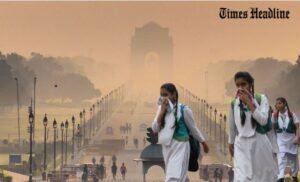By Priyanshi Jain

Delhi, the capital city of India, has been grappling with a severe air pollution crisis for several years now. The pollution levels in the city have reached alarming levels, posing a significant threat to the health and well-being of its residents. This article delves into the various factors contributing to Delhi’s air pollution problem and explores potential solutions to mitigate this environmental crisis.
In agreement with the Center’s air pollution control plan, if the AQI exceeds 450, all emergency measures, such as a prohibition on commercial four-wheeler, polluting trucks, and all forms of construction, must be implemented and enforced in the National Capital Region.
Causes of Pollution in Delhi
The air pollution in Delhi can be attributed to a multitude of factors:
- Vehicular Emissions:The ever-increasing number of vehicles on Delhi’s roads has led to a surge in harmful emissions.
- Industrial Pollution:The presence of numerous industries in and around Delhi releases pollutants into the air.
- 3.Construction Activities: The rampant construction activities contribute significantly to the dust and particulate matter in the atmosphere.
- 4.Variety in sentences: Construction activities in Delhi are a major contributor to the dust and particulate matter in the atmosphere.
- 5.Agricultural Burning: Burning of crop residues by farmers in neighboring states leads to the transportation of smoke and pollutants into Delhi.
Schools in Delhi shut till Nov. 18
The Directorate of Education has ordered advancing of the winter break for all the schools in Delhi in the wake of severe air quality levels prevailing in Delhi. According to the order, the schools will be totally closed from today to November 18 (Saturday) during which both children and teachers can stay home.Due to the increasing levels of pollution in the city.
Average AQI in different parts of city
The city’s 24-hour average Air Quality Index (AQI), measured at 4 pm each day, was at 426.
The air quality in neighbouring Ghaziabad (410), Gurugram (441), Noida (436), Greater Noida (467), and Faridabad (461) also reported hazardous air quality.
The Delhi Pollution Control Committee (DPCC) conducted an analysis and found that during the period of November 1 to November 15, when the number of stubble burning incidents in Punjab and Haryana increases, Delhi generally experiences peak pollution.
Delhi’s air quality ranks among the worst in the world’s capital cities.
Government Initiatives and Policies
The government of Delhi has implemented several measures to combat air pollution:
- The “Red Light On, Gaadi Off” campaign was an initiative by the Delhi Government in Oct-Nov 2020, urging drivers to switch off their vehicle engines while waiting at traffic signals.
- Introduction of the Odd-Even Scheme to regulate vehicular movement
- Imposing strict emission norms for industries and power plants.
Possible Solutions
To effectively address the air pollution crisis in Delhi, the following steps can be taken:
- Promoting the use of public transport and electric vehicles
- Sub-bullet points: Investing in the development of charging infrastructure
- Encouraging the adoption of cleaner technologies in industries
- Sub-bullet points: Providing incentives to industries for adopting sustainable practices
- Efficient waste management to minimize open burning and landfill emissions
- Sub-bullet points: Implementing waste segregation at source and promoting recycling.
Conclusion
Delhi’s air pollution problem demands urgent attention and concerted efforts from all stakeholders. By implementing stringent regulations, promoting sustainable practices, and raising awareness among citizens, we can work towards restoring clean and breathable air in the city. It is crucial for the government, industries, and individuals to come together to combat this environmental crisis and ensure a healthier future for Delhi’s residents.
